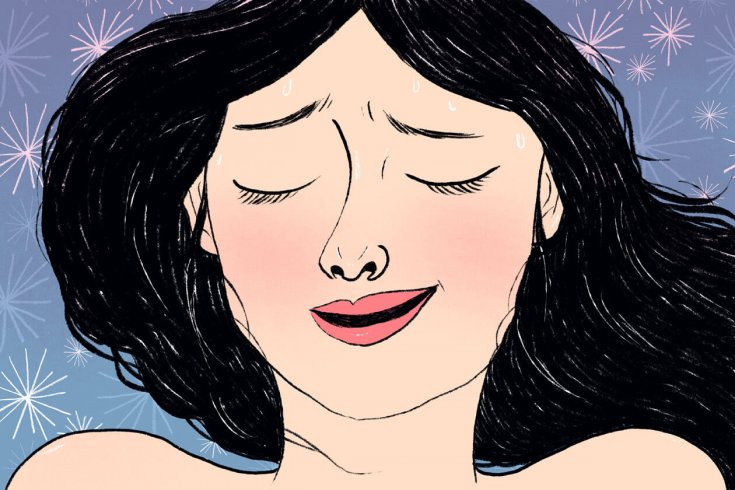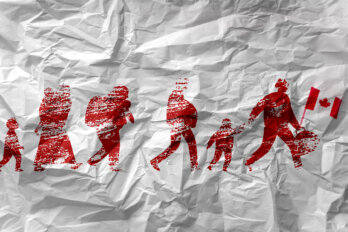The ladies trickle, slowly and tentatively, into the sex shop. Rather than turning right through the main door toward the sales floor’s hot-pink vibrators and tattooed staff, they keep left, climbing a narrow staircase into a little carpeted attic. They shake rainwater off their umbrellas and find seats in the circle of chairs, scooting around each other and mumbling “excuse mes” and “sorrys.” They look shyly at their laps, poke at their phones. One floor above the array of silicone toys promising advanced pleasure to the adventurous, these fifteen or so women aged twenty to sixty are here on a much braver quest: to learn how to have an orgasm. For nearly all, it will be their first one.
In contrast to the riotous main floor of Good For Her, Toronto’s sex store built for women, the quiet attic is solemn, its lights soft. The five-hour workshop, held on a drizzly Sunday morning in April, isn’t meant for drop-ins. Participants have planned many weeks in advance, driving in from surrounding suburbs, leaving kids with grandparents or husbands.
The store’s founder, Carlyle Jansen, stands, tall and self-contained. “This is probably the first time you’ve been around people who understand you,” she says softly. She asks everyone to say their name, a little about why they’re here and, lastly, to share something they have recently learned.
The room is quiet. Someone clears her throat.
“Hi, I’m Sherry. I’ve never had an orgasm,” begins one woman, with a mix of reluctance and relief. “Um . . . and I’m learning to salsa dance.”
“Thank you, Sherry,” says Jansen.
“My name’s Maya,” says a young woman (names and identifying details of participants have been changed). “I’ve never had an orgasm. Growing up I never masturbated or anything. I didn’t find it pleasurable. I just felt really like, Why am I doing this? Anyway. And juicing’s my new thing.”
Like alcoholics at an AA meeting, they each make their admission. There is Denise, who says apologetically that she’s “from the suburbs.” She laughs, then blurts out a story. “I was sexually molested by my cousin when I was seven. Messed up, right? I only lost my virginity when I was twenty-eight. I faked it.” Tears well up in her eyes.
The women are married, divorced, single. They’re all straight—except, perhaps, for one who keeps asking how she’d know if she was a lesbian. Dressed in sensible sweaters and jeans, they cross their ankles under their chairs. Most seem as though they have deliberately avoided the topic of whether they’re satisfied with their sex lives until now.
“I’m married,” says one woman. “We have a really loving marriage now, but for a while we had a pretty bad sex life. I remember after my son was born they didn’t stitch me up properly so it was very, very painful. And it didn’t matter to my husband, so I had to have sex a lot . . .”
“I was molested by my cousin when I was about thirteen,” says a participant named Kathleen. “I don’t think I knew I had a vagina until I was an undergrad. I thought I was frigid. And I don’t know if it’s because of what happened to me as a child or not, but I’ve never been—like, I can get myself to a precipice, but I can never . . . right?”
“Anybody feel like they get stuck on that edge, that precipice?” asks Jansen. There are muttered yeses.
“I feel it’s that my body might be ready to, but I’m not,” offers one woman.
“Anybody ever have the experience, you’re having sex but you’re just there, you’re not noticing what’s going on?” asks Jansen. “You’re not feeling what’s going on down there when you’re in your head thinking about ‘Am I going to have an orgasm? Am I not? Am I wet enough? Do I look sexy?’”
“And those noises,” offers a woman named Jill. “When you’re self-conscious, you’re like, ‘Oh, that sounds weird.’ How do you stop thinking? How do you stop thinking?’”
“For me there’s a lot of shame wrapped up in this topic.”
“I’m excited and I’m also terrified.”
“I’ve spent my whole life running the other way. And I’m ready to stop doing that.”
The women in the room don’t come from especially repressive households. For the most part, they hail from Toronto, Etobicoke, Guelph—in a province governed by a lesbian premier, surely among the most progressive places in the world for girls to grow up. Some have suffered trauma and molestation, but not all. What they share is a secret. This special thing that is supposed to happen in the bodies of ‘normal’ women—ideally in a shower of stars and rainbows and wow—refuses to happen, and they don’t know why. Some can’t touch themselves. Some won’t let anyone perform oral sex on them because they think their privates are “weird” and “dirty.” A couple of them have “gotten there”—but only if their partners aren’t in the room.
There is no pill they can take, no doctor they can see. The secret compounds with age: the older they get, the more some figure they should just let the whole thing go. To some, too, it feels self-indulgent to even complain about such a thing. What’s an orgasm, anyway? Just a momentary pop that disappears as soon as it’s begun. It’s not a real problem. Yet all these busy, seemingly practical women are here.
“I am afraid to have an orgasm,” says Denise. She leans forward, her bangs hanging over reddened eyes. “I’m afraid of losing control . . . I think I’ve come close, maybe. But I stop myself, because I’m afraid.”
“Yup. Anybody else?” asks Jansen.
Hands go up around the room.
A half-century ago, the story goes, there was a sexual revolution. Skirts got shorter, rock ’n’ roll got louder and sexuality was freed from its chains. We could pinpoint the exact moment, if we like, to 1956, when Elvis Presley caused a ruckus by gyrating his pelvis on black-and-white television: his hip-thrusting was so dangerous that the cameramen on The Ed Sullivan Show were instructed to film him from the waist up. Or maybe the revolution really happened in the sixties, when the birth control pill was approved in the US (and eventually Canada), permanently disentangling the act of intercourse from its most common hazard—pregnancy. In theory, it freed millions of women to do the thing men had always felt free to do.
From that decade onward, human sexuality was set loose to do its freaky, funky thing. Freudian psychology and the collective hormones of young baby boomers combined to liberate sex from the repressive jail it had been held in throughout history. It was all Ursula Andress in a wet bikini on the beach and copies of Playboy in the dentist’s office and Alfred Kinsey and Woody Allen telling us everything about which we were once, but no longer, afraid to ask.
Cut to a couple generations later, and our modern world is pure sex. Images of graphic coupling (or tripleting, or quintupling) are instantly available at the touch of a smartphone. The average music video has more high-definition close-ups of glistening, naked glutes than porn had in the seventies. Indeed, porn has become our mainstream aesthetic. Our ideal body is one that is sculpted, tanned, and hairless—ready for nudity at a moment’s notice, as if a tripod, some Klieg lights and a mustachioed director are always lurking around the next corner. In other words, the world couldn’t get any more liberated than it already is, and if it could, one wouldn’t want it to.
Reality, however, is more complicated. Although we appear liberated on the surface—our clothing, our language, and our media are more explicit than ever before—many of us feel overwhelmed, struggling to make space for our individual sexuality among so many idealized images. And if the person you ask is a woman, it may not be clear what the sexual revolution did for her.
A striking number of women today have a sexual complaint. Over half report some kind of difficulty with sex, according to Britain’s 2013 National Survey of Sexual Attitudes and Lifestyles, and more than one in ten are distressed about their sex life. Up to 40 percent of women aged sixteen to forty-four say they lack motivation to have sex. Dyspareunia, persistent pain during vaginal penetration, affects 8 percent of women, particularly those under thirty-five. The 2013 survey also found 16 percent of women complained of anorgasmia, the difficulty with or inability to orgasm, and 12 percent said they just don’t enjoy sex. Many more women have never climaxed, or aren’t sure—about 16 percent of women aged twenty-eight or younger, in fact. Amid the mainstream women’s magazines spurring us on to Bigger! Longer! and Multiples!, it’s an issue that must feel invisible.
Most striking is the so-called “orgasm gap”: a mere 57 percent of women aged eighteen to forty usually climax during sex with a male partner, while their partners come 95 percent of the time, according to a 2015 Cosmopolitan survey of over 2,300 women, conducted by Anna Breslaw et al. Keep in mind that these numbers come from cultures we think of as relatively sexually liberated—Canada, the US, and Great Britain.
In other words, a lot of ordinary women have a bad time in bed. But because we’ve avoided studying women’s sexuality for so long, we don’t have much of an understanding of why this is. Despite the rise of sexuality studies in the sixties and seventies and the eruption of new research on men’s sexual issues following the 1998 US Food and Drug Administration approval of sildenafil (Viagra) to treat erectile dysfunction, comparatively little research has been done into women’s sexuality (and even less has addressed the experiences of gay and trans men and women). A 2006 search of the US National Library of Medicine found it held 14,000 publications on male sexual disorders, but only 5,000 on those affecting women. That’s almost three times as many studies of male sexual problems than of those experienced by women, even though many experts characterize women’s sexuality as more complex.
Drug companies have been eyeing the ranks of unfulfilled women as a potential marketer’s bonanza. For years, a race has been on to develop a miracle treatment for women’s sexual ills—a pill, cream, injection, or even surgery that could give women the ability to feel urgent desire or to have bigger, more satisfying climaxes on demand. Dissatisfaction has made some women desperate for medical solutions. Some even risk painful and dangerous procedures such as clitoral-hood surgery, where tissue is cut away to increase sensitivity, as well as to try and emulate the neat, tidy genitalia seen in porn—a designer vulva. At stake in this medical push are untold profits: annual sales of Viagra stand at around (US) $2 billion. Its main developer, Simon Campbell, got a knighthood in 2014 for services rendered to science and mankind.
Despite nearly two decades of searching for a “pink Viagra,” however, drug companies have failed. Women’s sexual systems have proven reluctant to being jump-started by drugs. This is partly due to the greater complexity of women’s anatomical and nervous systems. But there is also the inconvenient fact that sexuality in women tends to involve our whole selves, not just our anatomy. How does one synthesize the intoxicating state of mind-body excitement so key to female arousal, or the feeling of safety and trust that is often essential for it? The answer is beyond the scope of pharmacology.
The only medication approved so far for the treatment of low desire in women, flibanserin (brand name Addyi) in 2015, is controversial. Doctors and researchers have criticized it as ineffective—women who took it had just one more ‘sexually satisfying event’ per month than those on a placebo—and even dangerous, with a risk of side effects such as low blood pressure and fainting. Vancouver sex therapist David McKenzie worries the drug will result in yet higher expectations on women. “[It] puts more pressure now on women, probably from male partners, to step up to the plate,” he told the Globe and Mail. Alongside drugs, a cottage industry of technology to artificially turbo-charge female sexuality has sprung up in recent years, including wired Kegel exerciser gadgets women can insert in their vaginas to gather data about the tightness of their vaginal walls (Still too loose—better do another hundred squeezes!), and the “G-shot,” an injection that purports to boost G-spot sensation.
Something is off about this picture. Being dysfunctional is so common that it’s the new normal. If women are as likely to have some kind of complaint as they are of being “functional,” do we need to rewrite our definition of ‘”functional”? What if female sexuality is not the problem—what if our idea of ‘normal’ is the problem?
“I demand that I climax.” In 2015, rapper Nicki Minaj made headlines when she told Cosmopolitan that women should demand pleasure. “I have a friend who’s never had an orgasm in her life. In her life! That hurts my heart. It’s cuckoo to me.” She says she and her friends “always have orgasm interventions where we, like, show her how to do stuff. We’ll straddle each other, saying, ‘You gotta get on him like that and do it like this.’”
She and comedian Amy Schumer must be comparing notes. “Make sure he knows that you’re entitled to an orgasm,” said Schumer in an interview with Glamour one month later, just one of several times she’s brought female pleasure to the fore. “I like to say it. I’ll be like, ‘Hey, there are two people here,’” Schumer continued. “I’ll be like, ‘Oh my God, have you met my clit?’ Don’t be self-conscious.” These appearances of the clitoris in mainstream media helped get 2015 declared the Year of the Female Orgasm by news site Mic.
There’s a reason two of the biggest female entertainers in America are speaking up about female pleasure, and it’s not to shock. It’s because they know ordinary women are speaking more and more like this already.
At the Good For Her workshop in Toronto, more than one woman confessed they were seized with fear when they tried to orgasm. But how could anyone be afraid of pleasure? Isn’t it the opposite—not coming—that’s supposed to be intolerable?
It’s been said that for women, sex is never an isolated act. Sexuality tends to affect and be affected by the rest of life. “Pleasure is all of you,” writes Emily Nagoski, author of female-focused sex guides called Come As You Are. It’s a process that results from the interaction of stress, memory, body image, nervous system, trust and even the smells in the room. That’s what makes medicating it nearly impossible. If pleasure scares us, it’s a sign we may want to heed rather than plow past. It may be a feature rather than a bug. Being exquisitely vulnerable while another person is witnessing your rolled-back zombie eyes and animal grunts can feel risky. If sex is worth it, writes author Mikaya Heart, it’s because “letting go of what other people think is the single most important thing you can do to improve the quality of your life in general and your sex life in particular.”
The women at the workshop spent five difficult hours learning their anatomy, hearing that what was between their legs wasn’t disgusting to their partners. They learned how to ask for what they wanted in bed, laughed, and confronted deep-set fears. The most powerful thing they learned as they listened to each other was that other women were just like them. They were normal after all.
Excerpted from Closer: Notes from the Orgasmic Frontier of Female Sexuality, published by Coach House Books, and launching in Toronto on July 6 at Studio Bar, 7 p.m.




